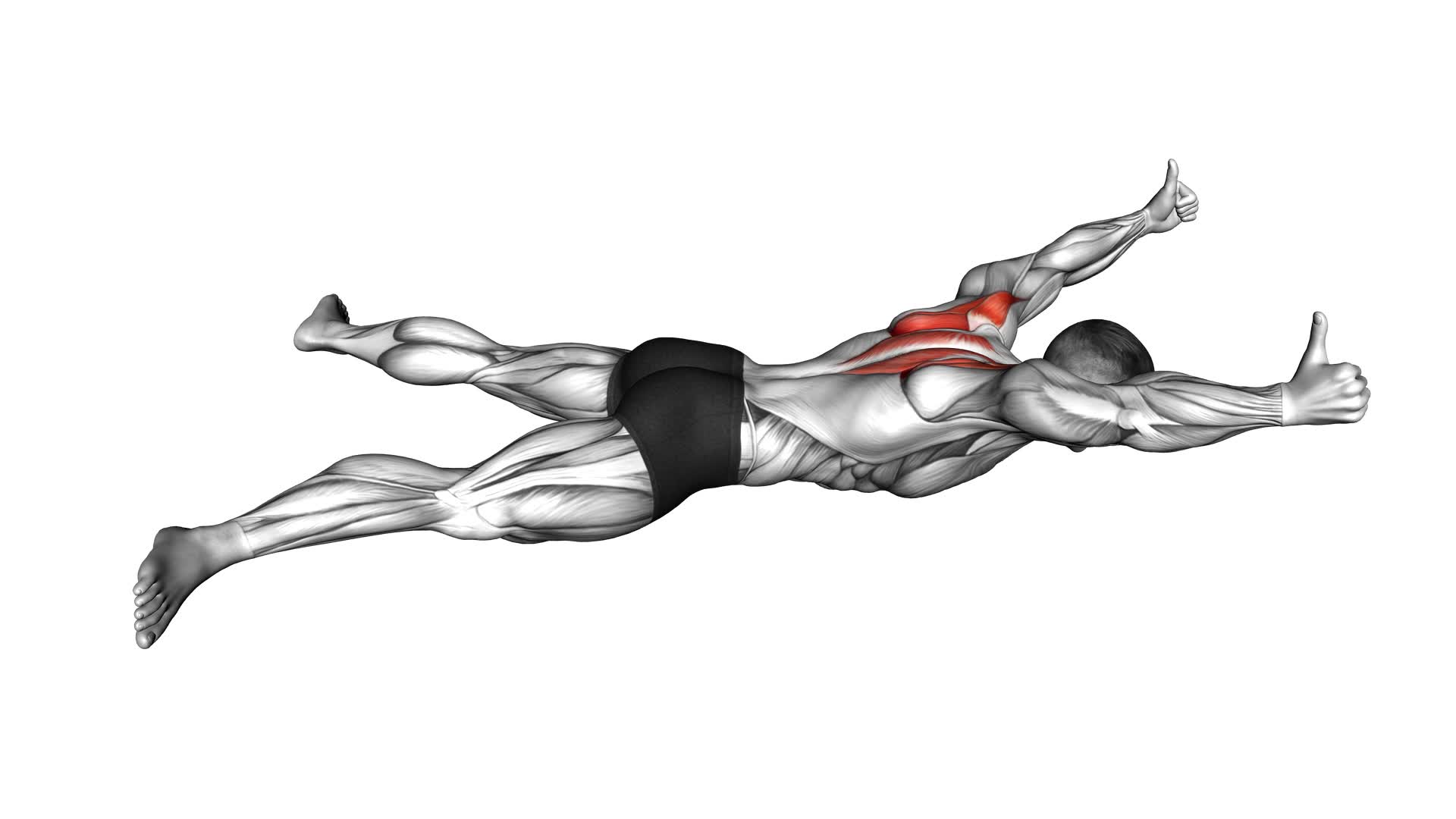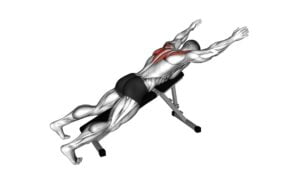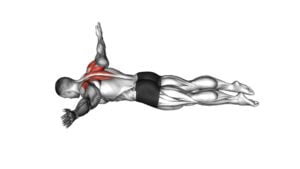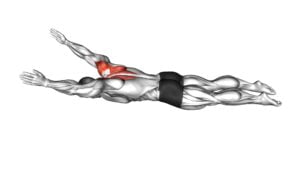Lying Prone Y Raise – Video Exercise Guide & Tips

Are you looking to improve your upper body strength and posture? Look no further than the Lying Prone Y Raise. This exercise targets your shoulders, upper back, and core, all while lying on your stomach.
Watch This Exercise Video
In this video exercise guide, we'll show you the proper form and technique, as well as modifications for different fitness levels. Maximize the effectiveness of your workout with these helpful tips.
Say goodbye to common mistakes and hello to a stronger you!
Key Takeaways
- The Lying Prone Y Raise targets the shoulders, upper back, and core, improving strength and posture.
- Modifications and variations can be made to accommodate different fitness levels, such as starting with lighter weights and gradually increasing resistance.
- Equipment needed for the exercise includes a mat or comfortable surface, dumbbells or resistance bands, and alternatives like water bottles or cans as makeshift weights.
- If limited on equipment, alternatives like the Superman exercise, Plank T Raises, Reverse Snow Angels, and Wall Angels can target similar muscle groups.
Benefits of the Lying Prone Y Raise
To experience the benefits of the Lying Prone Y Raise, you can strengthen your upper back and improve shoulder stability. This exercise targets the muscles in your upper back, including the rhomboids, traps, and rear deltoids. By lying face down on a bench or mat and extending your arms overhead in a Y shape, you engage these muscles to lift your arms up towards the ceiling. This movement helps to improve posture and counteract the effects of slouching or hunching over during daily activities.
There are various modifications and variations of the Lying Prone Y Raise that you can incorporate into your routine. For beginners or those with limited mobility, you can start by using lighter weights or no weights at all. As you progress, you can gradually increase the weight or resistance to further challenge your muscles. Additionally, you can perform the exercise on an exercise ball or stability disc to engage your core muscles and improve balance.
Equipment Needed for the Exercise
To perform the Lying Prone Y Raise exercise, you'll need some essential equipment.
This includes:
- A mat or a comfortable surface to lie on
- Dumbbells or resistance bands for added resistance
If you don't have access to dumbbells or resistance bands, you can use alternatives such as water bottles or cans as makeshift weights.
Having the right equipment will ensure that you can effectively engage your muscles and get the most out of this exercise.
Essential Equipment for Exercise
You will need specific equipment for the Lying Prone Y Raise exercise. Luckily, there are affordable options available that are also portable, making it convenient to perform this exercise at home or on the go.
One of the most common pieces of equipment used for this exercise is a resistance band. Resistance bands are lightweight, compact, and can easily be packed in your gym bag or suitcase. They come in different resistance levels, allowing you to adjust the intensity of the exercise according to your fitness level.
Another option is dumbbells, which are also portable and come in various weights. Choose a weight that challenges you but still allows you to maintain proper form throughout the exercise.
Remember to always consult with a fitness professional before starting any new exercise routine.
Alternatives for Limited Equipment
For the Lying Prone Y Raise exercise, you'll need either a resistance band or dumbbells to target your upper back and shoulder muscles effectively. However, if you don't have access to these equipment options, there are still alternative exercises you can do for a home workout that focus on bodyweight exercises.
Here are four alternatives for limited equipment:
- Superman: Lie face down on the floor with your arms extended in front of you. Lift your arms, chest, and legs off the ground simultaneously, engaging your back muscles.
- Plank T Raises: Start in a high plank position, then lift one arm up to the side, forming a T shape. Alternate arms and hold the position to engage your shoulder muscles.
- Reverse Snow Angels: Lie face down on the floor with your arms extended to the sides. Lift your arms up towards your head, squeezing your shoulder blades together, then lower them back down.
- Wall Angels: Stand with your back against a wall and your arms bent at 90 degrees. Slide your arms up and down the wall, maintaining contact with your elbows, wrists, and hands.
These alternative exercises can help you strengthen your upper back and shoulder muscles without the need for specialized equipment.
Proper Form and Technique
Perform the Lying Prone Y Raise exercise regularly to ensure proper form and technique. Proper form is essential for maximizing the benefits of this exercise and preventing injury.
One common mistake to avoid is lifting your upper body too high off the ground. This can strain your lower back and compromise the effectiveness of the exercise. Instead, focus on engaging your core and keeping your body in a straight line from head to toe.
Another mistake is allowing your shoulders to hunch up towards your ears. Keep your shoulders relaxed and down away from your ears throughout the movement.
To prevent injury, avoid jerking or using momentum to lift your arms. Instead, maintain a slow and controlled motion, emphasizing the contraction of your shoulder blades. As you raise your arms, imagine squeezing your shoulder blades together. This will help activate the target muscles and improve the effectiveness of the exercise.
By following these form and technique tips, you can perform the Lying Prone Y Raise exercise safely and effectively.
Transitioning into the next section about modifications for different fitness levels, it's important to note that this exercise can be adjusted based on your strength and flexibility.
Modifications for Different Fitness Levels
Now let's talk about modifications for different fitness levels when it comes to the lying prone Y raise exercise.
If you're a beginner, there are beginner-friendly modifications that can help you gradually build strength and improve your form.
On the other hand, if you're at an advanced level, there are adaptations you can make to challenge yourself even more.
Additionally, it's important to modify the exercise if you have any injuries or limitations to prevent further harm and promote proper healing.
Beginner-Friendly Modifications
To modify the lying prone Y raise exercise for different fitness levels, try using a resistance band. Here are some modifications you can incorporate:
- Beginner-friendly modifications:
- Use a lighter resistance band: If you're new to this exercise or have a lower fitness level, start with a lighter resistance band. This will help you build strength gradually and reduce the risk of injury.
- Decrease the range of motion: Instead of raising your arms all the way up into a Y position, start by lifting them only halfway. As your strength improves, you can gradually increase the range of motion.
- Injury prevention modifications:
- Perform the exercise on an incline: If lying prone on the floor is uncomfortable or too challenging, try doing the exercise on an incline bench. This will provide additional support and make it easier to maintain proper form.
- Engage your core muscles: To prevent strain on your lower back, engage your core muscles throughout the exercise. This will help stabilize your spine and protect against injury.
Remember to always listen to your body and adjust the exercise as needed to suit your fitness level.
Advanced Level Adaptations
As you progress to more advanced fitness levels, there are additional modifications you can make to the lying prone Y raise exercise to further challenge your muscles and enhance your strength and stability.
For advanced level modifications, consider performing the exercise with added resistance, such as holding dumbbells or using resistance bands. This will increase the intensity and engage your muscles even more.
Another variation for advanced practitioners is to perform the exercise on an unstable surface, such as a stability ball or a BOSU ball. This will require greater core activation and balance control.
Additionally, you can try performing the exercise with a slower tempo, focusing on the eccentric phase to increase the time under tension and stimulate muscle growth.
Remember to always maintain proper form and listen to your body to avoid injury.
Modifying for Injury Prevention
For injury prevention and modifications based on different fitness levels, consider using modifications that target specific muscle groups and provide support. Here are some modification alternatives to help you prevent injuries and cater to your fitness level:
- Reduce the range of motion: If you're new to the exercise or have limited mobility, start with a smaller range of motion. This will help you build strength gradually and prevent strain.
- Use lighter weights or resistance bands: If you're recovering from an injury or have a lower fitness level, using lighter weights or resistance bands can help reduce the strain on your muscles and joints.
- Focus on stabilization exercises: Incorporate exercises that improve your core stability and balance. This will provide a solid foundation for other movements and help prevent injuries.
- Seek guidance from a professional: If you have specific injuries or concerns, consult with a fitness professional or physical therapist. They can provide personalized modifications and guidance to ensure your safety and prevent further injury.
Tips for Maximizing the Effectiveness of the Exercise
Get the most out of the Lying Prone Y Raise exercise by focusing on proper form and engaging your upper back muscles. To maximize the results of this exercise, it's important to maintain proper alignment throughout the movement.
Start by lying face down on a mat with your arms extended overhead and your palms facing the floor. Keep your legs straight and your toes pointed towards the ground.
As you lift your arms and chest off the ground, focus on squeezing your shoulder blades together and engaging your upper back muscles. This will help to activate the targeted muscles and ensure that you're getting the most out of the exercise.
To further enhance the effectiveness of the Lying Prone Y Raise, you can also incorporate variations that target different muscle groups. For example, to engage your lower back muscles, you can perform a variation of this exercise by lifting your legs off the ground at the same time as your arms. This will create a more challenging movement and help to strengthen your entire back.
Remember to start with lighter weights or no weights at all and gradually increase the resistance as you become more comfortable with the exercise. By focusing on proper form and engaging the right muscles, you'll maximize the effectiveness of the Lying Prone Y Raise and see great results in your upper back strength and posture.
Common Mistakes to Avoid During the Lying Prone Y Raise
To ensure proper form and maximize the effectiveness of the Lying Prone Y Raise, it's important to avoid these common mistakes:
- Raising your head too high: One common mistake is lifting your head too high during the exercise. This can strain your neck and take the focus away from your shoulder muscles. Keep your head in a neutral position and focus on engaging your shoulder blades.
- Overarching your lower back: Another mistake to avoid is arching your lower back excessively. This can put unnecessary stress on your spine and decrease the effectiveness of the exercise. Maintain a neutral spine throughout the movement by engaging your core muscles.
- Using momentum: Using momentum instead of controlled movements is a common mistake that can reduce the effectiveness of the exercise. Slow and controlled movements are key to engaging the target muscles effectively.
- Neglecting proper breathing: Breathing is often overlooked during exercises, but it plays a crucial role in maintaining proper form. Remember to inhale as you lower your arms and exhale as you raise them, allowing for better control and engagement of the muscles.
Frequently Asked Questions
How Many Repetitions and Sets Should I Do for the Lying Prone Y Raise Exercise?
To determine the number of repetitions and sets for the lying prone Y raise exercise, you need to consider your fitness level and goals.
It's important to maintain proper form throughout the exercise to avoid injury.
Start with a lower number of repetitions and sets, such as 2 sets of 8-10 repetitions, and gradually increase as you get stronger.
Remember to rest between sets to allow your muscles to recover.
Can I Perform the Lying Prone Y Raise Exercise if I Have a Shoulder Injury?
If you have a shoulder injury, it's important to be cautious when performing the lying prone Y raise exercise. It may not be suitable for you at this time.
Instead, consider alternative shoulder exercises that are less likely to aggravate your injury. You can also modify the lying prone Y raise by using lighter weights or performing the exercise with your arms at a lower angle.
Always consult with a healthcare professional for personalized advice.
Is It Necessary to Warm up Before Doing the Lying Prone Y Raise Exercise?
Before performing the lying prone Y raise exercise, it's important to warm up. Warming up helps to increase blood flow, improve flexibility, and reduce the risk of injury. By warming up, you prepare your muscles and joints for the exercise, allowing for better performance and increased benefits.
Additionally, warming up can also help you to become more mentally focused and engaged in the exercise. There are various warm-up exercises and stretches that you can incorporate before starting the lying prone Y raise.
Can I Incorporate Weights or Resistance Bands in the Lying Prone Y Raise Exercise?
Yes, you can incorporate weights or resistance bands into the lying prone Y raise exercise. This will help to increase the intensity and challenge your muscles even more.
However, it's important to start with lighter weights or lower resistance bands and gradually increase as you get stronger.
If you have a shoulder injury, it's recommended to consult with a physical therapist or fitness professional for modifications that are safe and appropriate for your condition.
How Often Should I Include the Lying Prone Y Raise Exercise in My Workout Routine for Optimal Results?
For optimal results, it's important to consider the frequency of including the lying prone Y raise exercise in your workout routine.
The workout frequency will depend on your goals and overall fitness level. To enhance the effectiveness of this exercise, it's recommended to perform it 2-3 times per week.
However, it's always advisable to consult with a fitness professional to personalize your routine and ensure it aligns with your specific needs and goals.
Conclusion
In conclusion, the lying prone Y raise is a beneficial exercise that targets the muscles in your upper back and shoulders. By using proper form and technique, you can maximize the effectiveness of this exercise and avoid common mistakes.
Remember to adjust the exercise to your fitness level and use the necessary equipment.
Incorporating lying prone Y raises into your workout routine can help improve your posture and strengthen your upper body.

Author
Years ago, the spark of my life’s passion ignited in my mind the moment I stepped into the local gym for the first time. The inaugural bead of perspiration, the initial endeavor, the very first surge of endorphins, and a sense of pride that washed over me post-workout marked the beginning of my deep-seated interest in strength sports, fitness, and sports nutrition. This very curiosity blossomed rapidly into a profound fascination, propelling me to earn a Master’s degree in Physical Education from the Academy of Physical Education in Krakow, followed by a Sports Manager diploma from the Jagiellonian University. My journey of growth led me to gain more specialized qualifications, such as being a certified personal trainer with a focus on sports dietetics, a lifeguard, and an instructor for wellness and corrective gymnastics. Theoretical knowledge paired seamlessly with practical experience, reinforcing my belief that the transformation of individuals under my guidance was also a reflection of my personal growth. This belief holds true even today. Each day, I strive to push the boundaries and explore new realms. These realms gently elevate me to greater heights. The unique combination of passion for my field and the continuous quest for growth fuels my drive to break new ground.







